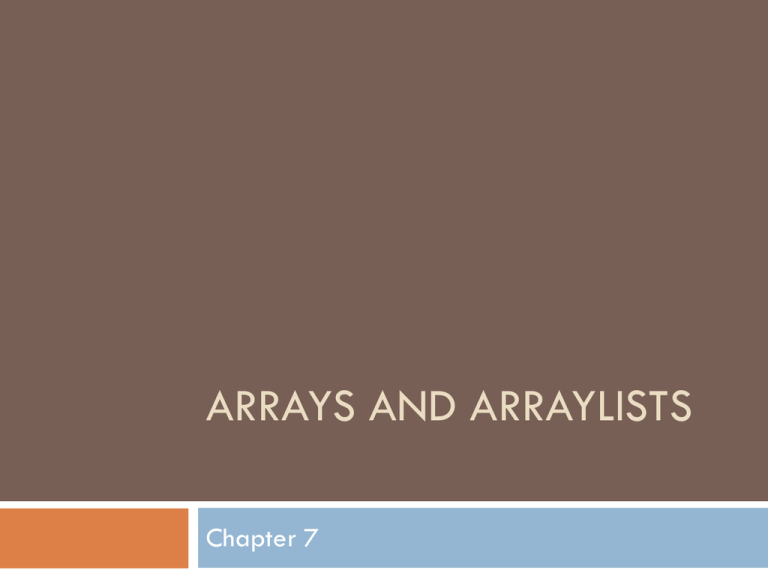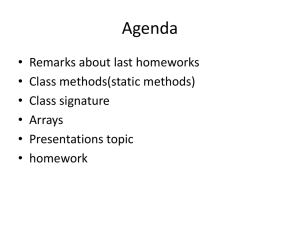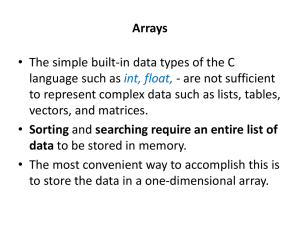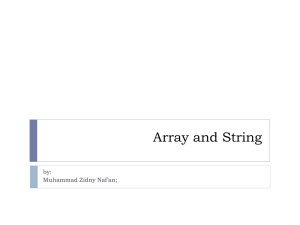Java - Chapter 7
advertisement

ARRAYS AND ARRAYLISTS
Chapter 7
Array
Sequence of values of the same type
Primitive
types
Objects
Create an Array
double[]
values = new double[10]
int[] values = {2,4,5,6,7,8,9}
BankAccount[] accounts=new BankAccount[10]
Definitions
Length of array
Number
of declared elements
Used or unused
Element type
Type
of the array
Index
Access
Integer
to the array
Differences Between Java and Visual Logic
Visual Logic
Do
not have to define type of array
Use ( ) to surround index number
Java
Have
to define type of array
Must use the new operator when creating the array
Use [ ] to surround index number
Default Initialization of Array Elements
Array of numbers (int or double) = 0
Array of boolean = false
Array of objects = null
Arrays and Memory
double[]
values
0
0
0
0
Add Value
double[]
values
0
Values[1] = 10.0
10.0
0
0
More Definitions
Index values – range from 0 to length-1
Bounds error
Accessing
a non existent elements
Program terminate
values.length() – method to get the length of the
array named values
Parallel arrays
2
or more arrays used to describe one thing
Parallel Arrays
Student name
Student age
Student gpa
String[] name = new String[10]
int [] age = new int[10]
double [] gpa = new double[10]
Avoid change to array of object
Major Problem With Array
Length is fixed
Array can develop “holes in delete” or “add”
Won’t
know if array is full
Array List
Allows you to collect objects just like arrays.
Can grow and shrink as needed
Has methods for inserting and deleting objects.
Will not work on primitive types
ArrayList / Generic Class
A
ArrayList<String>
names = new
ArrayList<String>();
Notice the type of objects are in <>.
These are called generics.
Generics are used when you want anytype in its
place.
Will study later. Maybe next semester.
How To Use Array Lists
names.add(“Kathy”);
Add elements to end
System.out.println(names)
Prints [Kathy]
names.add(1,”Bob”)
Inserts Bob before Kathy
names.remove(0)
removes first element - Bob
names.set(0,”Bill”)
removes Kathy
puts Bill in Kathy’s place
gets the first element
String name = names.get(0)
String name =
namew.get(names.size()-1)
gets last element
Wrapper Classes
The object class for a
corresponding primitive
type
Can convert from
primitive to wrapper
Can store Wrapper in
ArrayList
Convert int to Integer
Use Array List of type
Integer
Primitive
byte
boolean
char
double
float
int
long
short
Wrapper
Byte
Boolean
Character
Double
Float
Integer
Long
Short
Converting From Primitive to Wrapper
Converting from primitive to Wrapper Class is
called “auto-boxing”
Double
Converting from Wrapper Class to primitive is
called “auto-unboxing”
double
d = 29.95
dd = d;
Can still do arithmetic
Double
dPlus = d +1;
d was unboxed. One was added. The result was boxed
and placed in dPlus.
Enhanced for Loop
Shortcut
Traverses all elements of a collection
double [] values = ………….;
double sum = 0;
for (double element : values)
{
sum = sum+ element;
}
Loop variable contains an element not index.
Partially Filled Array
arrayName.length() gives number of elements
Does not give how many are used
Keep a companion value to track how many
elements are used.
Removing an Element
Remove the 4th element of eight
Array List
Use
the remove method
Necessary shifts will take place 5th will move to 4th, and
previous 6th to 5th etc.
You do nothing
Array
You
have to do all the necessary shifts
Inserting An Element
Array List
If
order doesn’t matter simply use
arrayListName.add(element)
If
order does matter use
arrayListName.add(position,
element)
Array
If
order doesn’t matter
use
If
index of next available opening
order does matter
must
shift to create opening
Copying an Array
An array variable stores a reference to the array.
Copying yields a second reference to the same
array.
to create a true copy use copyOf
Copying and Growing an Array
int[] value = new int[10];
int valueSize = 0;
while (in.hasNextDouble())
{
if (valuesSize == values.length)
values =
Arrays.copyOf(values,2*values.length);
value[valueSize] = in.nextDouble();
valuesSize++;
}
Multiple-Dimensional Arrays
2 Dimensions
String[][]
board = new String[rows, columns]
rows and columns = some values
3 Dimensions
String[][][]
board = new String[2][3][4]








